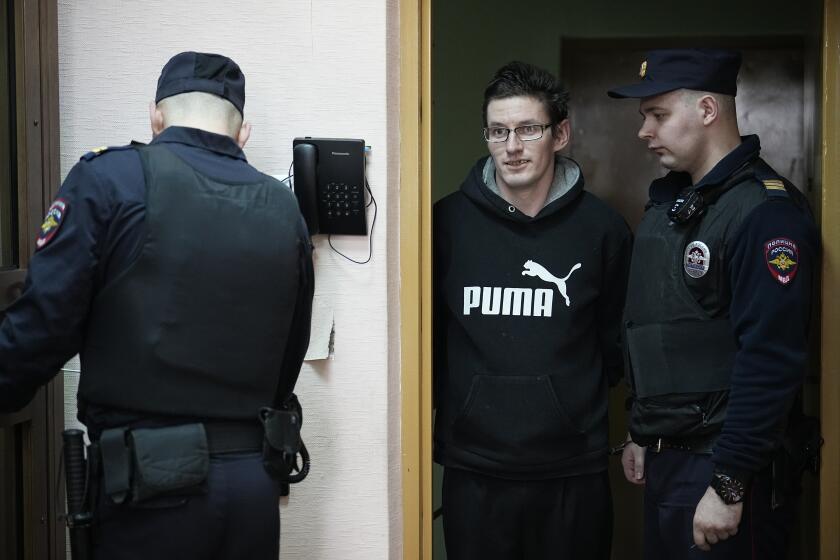A Local Pest Becomes the Key to a Better Life
All day Emily Rooinasie tried to spin wild cocoon silk into thread, but her stiff, arthritic hands would not cooperate.
Her eyes blurred with tears of frustration. Finally, she tore off her green plastic apron, walked out of the silk factory and home to her one-room tin shack on the edge of the Kalahari Desert, where she cried over what she thought was a wasted chance.
Jobs are practically nonexistent in her black township in southern Namibia, where thin, scabby dogs lie in the morning sunshine and defeated people are already getting drunk. It is here that Ian Cumming, an amateur silk enthusiast from South Africa, hatched the idea to use the cocoons of a local pest to make a thing of beauty.
In Leonardville, old folks would roast the cocoons of the African wild silk moth, gonometa postica, and eat the worm inside, but making cloth out of them was inconceivable to Rooinasie.
“I always wondered how people make clothes,” said the 62-year-old. “We didn’t know these things and now we know. It makes me feel proud.”
Cumming chose about two dozen of the neediest people in the village to work, mainly poor widows or single mothers. Now they have a new power and status in their community, “because we work and we give them food,” Rooinasie said. When the women return home in the evening, dinner is always prepared for them.
Rooinasie acknowledges that she would have given up trying to spin the gossamer thread if not for Cumming’s constant prodding and advice.
“I’m very happy he didn’t send me home when I couldn’t get it right,” Rooinasie said. “I thought I was stupid, that I could never learn how to spin. I cried and I got very angry too.”
“I knew she could do it,” Cumming said. “I said, ‘Try it, just persevere.’ ”
The enterprise, 50% owned by workers, uses the cocoons of a moth that has long plagued the farmers of the Kalahari. Cattle and wildlife eat the cocoons, which form a dense mat in the stomach, killing the animals. With Cumming’s factory, the cocoons have a useful -- and lovely -- purpose.
The silk factory uses only hatched cocoons to ensure sustainability, giving it a niche in the “eco-fashion” and “conscience commerce” markets.
In traditional silk production, the fine strand of an intact cocoon is unwound, killing the pupae. With the Kalahari method, some fibers are broken when the moth breaks out of the cocoon, resulting in a coarser silk.
“Some of our spinners are really good and some still struggle,” Cumming’s wife, Jenny, said as she picked up a small piece of green wild silk fabric and fingered it lovingly. “That’s what makes it so interesting and gives it a different texture. Look, there you find this thick strand and you will find a thin strand, which I find totally appealing.”
Edun, the international fashion company owned by U2 lead singer Bono and his wife, Ali Hewson, buys products that offer fair trade and job opportunities in the developing world. Edun is experimenting with the Kalahari wild silk and considering its inclusion in the company’s spring 2007 collection.
Projects funneling indigenous African products to international markets could offer new life to towns such as desperately poor Leonardville, with a population of 1,200 and about 95% unemployment.
But after three years of research and three years of production, the Kalahari Wild Silk Co. is still vulnerable. It needs to double its output to be viable, but has no ready source of capital for expansion.
It takes focused, painstaking work to link poor communities with markets they have no concept of and to marry small cottage industries with the demands of Western businesses for steady, large-scale supply.
Cumming used to sell price-marking equipment in South Africa. After a vacation in Madagascar in the early 1990s, he gave up his job and moved there.
In Madagascar, wild silk is used in a death ritual, famadihana, the turning of the bones. Every few years, a family exhumes the remains of a revered ancestor, re-wraps the bones in a new funeral shroud, or lamba, of tightly woven wild silk, and takes the bones around the town, relating all the news since the last exhumation. A huge party is thrown.
The Cummings zipped from village to village on a motorbike, trading silk and buying cocoons. They cleaned the lamba silk and made clothing: There was great hilarity in the village market at the sight of a white man wearing a dead man’s clothing.
Ian Cumming came up with the wild silk project in 2000. Funding from the global relief agency Oxfam and the Namibian government established the wild silk factory in 2003.
Some Namibians thought Cumming was a little mad when he turned up with a truckload of cocoons and explained the concept to them.
“We all just hoped that he’d manage to get it right so we’d all have jobs,” said Veronica Nunuhes, 35, a weaver at the factory.
The black township, a stretch of closely packed tin shacks that are roasting hot in summer, squats where the ragged edges of Leonardville give way to the Kalahari Desert.
It’s a place racked by unemployment, alcohol abuse and more banal troubles, such as the daily problem of finding wood for cooking.
“One of my sons is drinking. He has lots of friends and they drink all his money. One day they’re going to drop dead,” said Rooinasie, the first person in town to ask Cumming for work.
Rooinasie is the breadwinner for her disabled mother, two sons, seven daughters and four grandchildren. At the factory, she earns about 600 Namibian dollars a month, just over U.S. $100, depending on her output. The faster spinners earn as much as $155 a month, making them some of the best-paid workers in the area.
Each day, Rooinasie takes her spinning wheel to a quiet corner or out under a tree, away from the distracting chatter of the other spinners. She sits bowed over her work, sometimes gazing into the distance.
“I can think my own thoughts and relax at my work,” she said peacefully.
She says the job improved her life immensely and gave hope to the whole community.
“It’s changed the way people in the township think. Everyone wants a job in the factory. I hope I’ll be able to educate my daughter’s children. Maybe they can be nurses or teachers or magistrates.”
Half a world away is Christian Kemp-Griffin, chief executive of Ireland-based Edun, firing e-mails around the globe from Dublin or Paris or New York from his mobile phone.
When Kemp-Griffin first saw the wild silk, he loved its texture and sheen. But most of all he loved the story of the fabric and the people who make it.
“When you put a garment on, you can’t discount where it comes from,” he said.
One of Edun’s designers, Young Song, has been working on ways of lining the loose-weave fabric. Edun will complete its collection for next spring by the end of June, but it is not yet clear whether Kalahari wild silk will make the cut.
“It’s not an easy fabric to work with,” Kemp-Griffin said. “I don’t want to raise false hopes. But I am going to do my best to see it stays in the line.”
It would be difficult for the wild silk factory to fill orders from an established large designer, he said. But keeping up with Edun, only 18 months old and still operating on a smaller scale, should be easier.
“One of the things Edun would like to do is invest in some of these micro-projects. This project could grow with Edun,” Kemp-Griffin said.
After Oxfam’s five-year funding ran out, advertisements were placed for someone to commercialize the wild silk project, but no one was found locally.
The Cummings took over management and leased the operation, trying to expand production and develop markets. The government is to transfer its 50% share to the Leonardville council.
“We’re just working-class people. We don’t have any money to put in,” Jenny Cumming said. “When I said, ‘Let’s take it over,’ Ian said, ‘Jenny, how are we going to survive?’ I just said, ‘We’ll survive.’
“We’ve taken something that had only overheads and we’ve tried to turn it into a business. It hasn’t been easy.”
At first, the factory struggled to find markets. Now it has markets but has difficulty filling orders.
The factory makes no profit yet. It is trying to increase production by purchasing more hand looms, but capital is short.
“We are still at threat,” Ian Cumming said. But he said the women at the factory understood the risk and were working longer days.
Over the Easter weekend, all the workers put in long shifts to fill an important order from a South African client.
“Because people are buying more silk, I’m trying to make more silk,” Rooinasie said. “If I can do my work, I feel good.”
More to Read
Start your day right
Sign up for Essential California for news, features and recommendations from the L.A. Times and beyond in your inbox six days a week.
You may occasionally receive promotional content from the Los Angeles Times.






